Related Research Articles

Douglas, on the South Side of Chicago, Illinois, is one of 77 Chicago community areas. The neighborhood is named for Stephen A. Douglas, Illinois politician and Abraham Lincoln's political foe, whose estate included a tract of land given to the federal government. This tract later was developed for use as the Civil War Union training and prison camp, Camp Douglas, located in what is now the eastern portion of the Douglas neighborhood. Douglas gave that part of his estate at Cottage Grove and 35th to the Old University of Chicago. The Chicago 2016 Olympic bid planned for the Olympic Village to be constructed on a 37-acre (150,000 m2) truck parking lot south of McCormick Place that is mostly in the Douglas community area and partly in the Near South Side.
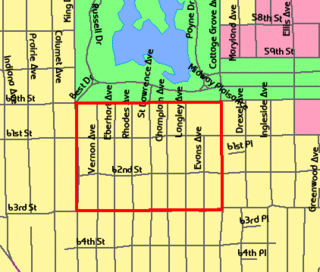
The Washington Park Subdivision is the name of the historic 3-city block by 8-city block subdivision in the northwest corner of the Woodlawn community area, on the South Side of Chicago in Illinois that stands in the place of the original Washington Park Race Track. The area evolved as a redevelopment of the land previously occupied by the racetrack. It was originally an exclusively white neighborhood that included residential housing, amusement parks, and beer gardens.
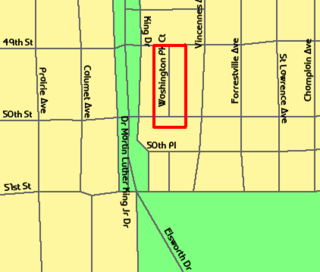
The Washington Park Court District is a Grand Boulevard community area neighborhood on the South Side of Chicago, Illinois. It was designated a Chicago Landmark on October 2, 1991. Despite its name, it is not located within either the Washington Park community area or the Washington Park park, but is one block north of both. The district was named for the Park.
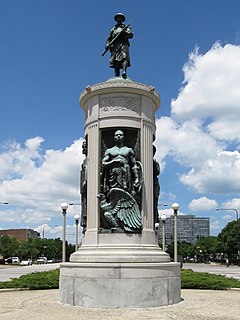
Erected in 1927, the Victory Monument, created by sculptor Leonard Crunelle, was built to honor the Eighth Regiment of the Illinois National Guard, an African-American unit that served in France during World War I. It is located in the Black Metropolis-Bronzeville District in the Douglas community area of Chicago, Illinois. The structure was added to the National Register of Historic Places on April 30, 1986. It was designated a Chicago Landmark on September 9, 1998. An annual Memorial Day ceremony is held at the monument.

The Chicago Defender Building is the former Jewish synagogue that housed the Chicago Defender from 1920 until 1960. It was designated a Chicago Landmark on September 9, 1998. The building is in the Black Metropolis-Bronzeville District in the Douglas community area of Chicago, Illinois at 3435 S. Indiana Ave. It was designed by Henry L. Newhouse. You can read more about the nine designated landmarks, including the Chicago Defender Building and Robert S. Abbott, the newspaper's publisher, in this document from the City of Chicago Department of Planning and Development, The Black Metropolis - Bronzeville District.

Black Metropolis–Bronzeville District is a historic African American district in the Bronzeville neighborhood of South Side, Chicago, Illinois.

The Chicago Bee Building is a historic building on Chicago's South Side. It originally housed the Chicago Bee, a newspaper serving the African Americans of Chicago. The building now houses the Chicago Bee Branch of the Chicago Public Library. The building was named a Chicago Landmark on September 9, 1998. It is located in the Black Metropolis-Bronzeville District in the Douglas community area of Chicago, Illinois.

Wabash Avenue YMCA is a Chicago Landmark located within the Chicago Landmark Black Metropolis-Bronzeville Historic District in the Douglas community area of Chicago, Illinois. This YMCA facility served as an important social center within the Black Metropolis area, and it also provided housing and job training for African Americans migrating into Chicago in the early 20th century. In 1915, the Association for the Study of Negro Life and History, one of the first groups specializing in African-American studies, was founded at YMCA.
The Elam House, originally Simon Marks House, is a chateauesque-style residential building at 4726 South Martin Luther King Jr. Drive in Chicago, Illinois, United States. The house was designed by Henry L. Newhouse and built in 1903. It was later purchased by Melissia Ann Elam. It was designated a Chicago Landmark on March 21, 1979.

Hygienic Manufacturing Company, also known as Overton Hygienic Company, was a cosmetics company established by Anthony Overton. It was one of the nation's largest producers of African-American cosmetics. Anthony Overton also ran other businesses from the building, including the Victory Life Insurance Company and Douglass National Bank, the first nationally chartered, African-American-owned bank. The Overton Hygienic Building is a Chicago Landmark and part of the Black Metropolis-Bronzeville District in the Douglas community area of Chicago, Illinois. It is located at 3619-3627 South State Street.
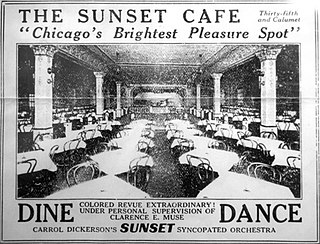
The Sunset Cafe, also known as The Grand Terrace Cafe, was a jazz club in Chicago, Illinois operating during the 1920s, 1930s and 1940s. It was one of the most important jazz clubs in America, especially during the period between 1917 and 1928 when Chicago became a creative capital of jazz innovation and again during the emergence of bebop in the early 1940s. From its inception, the club was a rarity as a haven from segregation, since the Sunset Cafe was an integrated or "Black and Tan" club where African Americans, along with other ethnicities, could mingle freely with white Americans without much fear of reprisal. Many important musicians developed their careers at the Sunset/Grand Terrace Cafe.

The Eighth Regiment Armory, located in the Black Metropolis-Bronzeville District of Chicago, Illinois, was the first armory in the United States built for an African-American military regiment, known as the "Fighting 8th". The building later was used by a division of the Illinois National Guard, and during World War I was incorporated into the US Infantry. After closing the armory in the early 1960s, it became the South Central Gymnasium. In 1999, following an extensive renovation, it was reopened as a public high school military academy. The restoration and conversion into a school has been recognized by the National Trust for Historic Preservation.

The South Side is an area of Chicago. It is the largest of the three Sides of the city that radiate from downtown—the others being the North Side and the West Side.

Washington Block is a Chicago Landmark building located in the Loop community area of Chicago, Illinois, United States. Designed by Frederick and Edward Baumann it was built between 1873–1874 in the aftermath of the Great Chicago Fire of 1871. It was designated a Chicago Landmark on January 14, 1997. When completed, Washington Block was one of the tallest buildings in the city of Chicago and is described as a rare example of the "isolated pier foundation" which contributed to the foundation of knowledge that has made Chicago the birthplace of the skyscraper. The building has limestone facades and originally included an exterior staircase that led to a second-floor corner entrance. The lobby has a curving hardwood staircase. Today the first floor is occupied by a 7-Eleven and the second floor occupied by Carter Legal Group PC. The building, which is located at the corner of North Wells Street and West Washington Street is five stories tall.
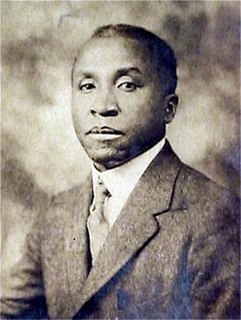
Walter Thomas Bailey was an American architect from Kewanee, Illinois. He was the first African American graduate with a bachelor of science degree in architectural engineering from the University of Illinois at Urbana-Champaign and the first licensed African-American architect in the state of Illinois. He worked at the Tuskegee Institute, and practiced in both Memphis and Chicago. Walter T. Bailey became the second African American that graduated from the University of Illinois.

The Ida B. Wells Homes, which also comprised the Clarence Darrow Homes and Madden Park Homes, was a Chicago Housing Authority (CHA) public housing project located in the heart of the Bronzeville neighborhood on the South Side of Chicago, Illinois. It was bordered by 35th Street to the north, Pershing Road to the south, Cottage Grove Avenue to the east, and Martin Luther King Drive to the west. The Ida B. Wells Homes consisted of rowhouses, mid-rises, and high-rise apartment buildings, constructed to house African American tenants. They were demolished beginning in 2002 and ending in 2011.

Unity Hall is a historic building located at 3140 S. Indiana Ave. in the Douglas community area of Chicago, Illinois. Built in 1887, the building originally served as a Jewish social club called the Lakeside Club. The red brick building, designed by local architect L.B. Dixon, features terra cotta decorations and sheet metal edging. In 1917, Chicago alderman Oscar Stanton De Priest founded the Peoples Movement Club and made Unity Hall its headquarters. De Priest was the first African-American to serve on the Chicago City Council, and he established the Peoples Movement Club to organize the black community politically. The Peoples Movement Club became "one of the best organized political groups" in Chicago's Black Metropolis neighborhood, and De Priest became the first African-American U.S. Representative from the northern states in 1928.
The Chicago Bee or Chicago Sunday Bee was a Chicago-based weekly newspaper founded by Anthony Overton, an African American, for primarily African-American readers. The paper was committed to covering "wholesome and authentic news", and adopted a middle-class, conservative tone. Politically, it was aligned with the Republican Party.

Frank L. Gillespie was a businessman who created the first African American-owned life insurance agency outside of the U.S. southern states. Gillespie had been an agent at Royal Life Insurance Company, a white-owned insurance agency, working in the "department for colored people" and noticed his customers were offered "inferior products." He met with a group of prominent black businessmen in Chicago and they worked together to create an insurance company catering towards Chicago's professional African American population.
Clarence Henry Cobbs was an African-American spiritualist clergyman and broadcaster, the leader of the First Church of Deliverance in Chicago.
References
- 1 2 "Supreme Life Building". Chicago Landmarks. City of Chicago. Retrieved October 31, 2013.
- ↑ Bey, Lee (September 16, 1996). "Revival sign in Bronzeville". Chicago Sun-Times .
- 1 2 Bey, Lee (August 16, 1996). "Bronzeville landmark guaranteed a new life". Chicago Sun-Times .
- ↑ "About Us". Bronzeville Visitor Information Center. Retrieved October 31, 2013.